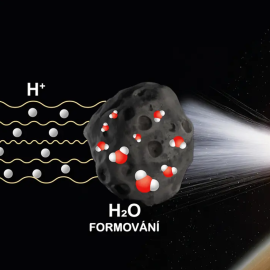New Research Suggests a Stellar Source of Earth’s Water
A groundbreaking study by Professor Civiš's team from the J. Heyrovský Insitutute of the Czech Academy of Sciences recently published in the prestigious Astrophysical Journal, explores a potential origin of water on Earth. The research highlights the contribution of stellar winds to water formation on the surfaces of oxide minerals.
Using infrared spectroscopy and temperature-programmed desorption (TPD), the scientists discovered that when oxygen-rich minerals are bombarded with hydrogen atoms, water molecules form and adhere tightly to the mineral surfaces. These molecules remain stable even under extremely low pressures (10⁻⁹ Torr) and high temperatures, enabling their long-term retention and transport across vast distances in space. This suggests that stellar winds might play a significant role in delivering water not just to Earth but to other bodies within the solar system.
The study involved 14 samples of oxygen-rich minerals, including two meteorites, and found that the water adsorption capacity ranged between 0.09% and 0.7%. Based on this, the researchers propose that solid material delivered to Earth during the Late Heavy Bombardment (LHB)—estimated at 10¹⁹ to 10²⁰ kg—could have contributed significantly to the water now forming Earth’s oceans. This supports the hypothesis that water's origins may be linked to processes occurring on the surfaces of dust grains and minerals exposed to cosmic radiation.
The findings extend beyond our solar system, suggesting that stellar winds may continuously replenish water adsorbed on minerals throughout the universe. This new perspective on the interaction between cosmic radiation and minerals underscores the importance of these processes in the formation and distribution of water within planetary systems.
This research opens a window into understanding how water may have emerged in distant parts of the cosmos, reshaping our comprehension of water’s origins in planetary environments.




























